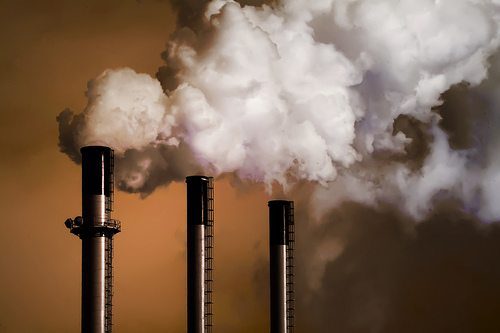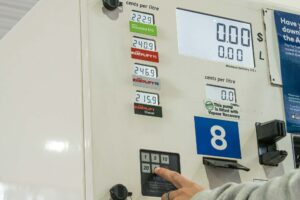Just as US President Barack Obama moves ahead with even tougher cuts on greenhouse gas emissions from power plants across the country, a new report out of Australia has highlighted just how ineffectual the Abbott government’s key climate policy – Direct Action – will be in cutting industrial emissions.
The report, released by energy market analysts RepuTex on Monday, suggests that just 30 of Australia’s 150 largest emitting companies will be required to reduce emissions under the government’s Emissions Reduction Fund (ERF) “Safeguard Mechanism” – a “light touch” approach, says RepuTex, that will render the policy ineffective.

Moreover, Reputex’s analysis finds that none of Australia’s 20 largest emitting facilities are expected to be accountable for their emissions, despite almost all being forecast to grow emissions over the next 10 years.
Here’s why: The Coalition’s so-called Safeguard Mechanism means to establish emissions baselines for around 150 companies from July 1, 2016, in an effort to ensure emissions reductions purchased through the $2.55 billion ERF are not displaced by a rise in emissions elsewhere in the economy.
But According to RepuTex, the majority of these proposed pollution baselines will be set so high, the companies will not exceed them, even if their emissions grow.
This is because the scheme proposes to set historic baselines at the ‘high point’ of each existing facility’s emissions over the past five years, the report explains.
Given industry emissions have generally fallen over the last five years, this will allow companies to increase their emissions from current levels without facing a liability.
As the report notes, the findings place further pressure on the government to explain how it will curb emissions growth, ahead of the announcement of Australia’s post-2020 emissions target, scheduled for after Parliament resumes next week.
They also highlight just how far behind other major economies Australia stands on emissions reduction and climate change policy.
In the US on Sunday, President Obama moved ahead with unprecedented pollution controls for American power plants, as part of an effort to secure a legacy on fighting global warming that would extend beyond the 2016 presidential campaign.
“Climate change is not a problem for another generation,” Obama said in a video posted to Facebook. “Not anymore.”
On top of this, more than a dozen US corporate giants signed up to a government-led pledge to slash their emissions and invest up to $140 billion in low-carbon investments – including 1.6GW of renewable energy capacity – last week, in a demonstration of their support for a global climate change deal at the UN’s Paris Summit in December.
http://www.washingtonpost.com/business/obama-to-unveil-final-power-plant-emissions-limits-on-monday/2015/08/02/5b61252c-38cd-11e5-ab7b-6416d97c73c2_story.html
So, while the US government tightens the screws on its heavy emitting power companies, and invites others to self-regulate, the Abbott government’s key policy effectively provides “a significant amount of headroom” to grow emissions, says RepuTex executive director Hugh Grossman.
“With baselines set so high, we project that emissions will actually grow under the safeguard scheme – by around 20 per cent – so the policy will fail to curb emissions growth, let alone assist in reducing emissions to meet our new post-2020 emissions target,” he said.
The report notes that, of the 30 companies expected to be caught by the government’s baseline scheme – operating 85 facilities – existing metals manufacturing, coal mining, oil and gas, and transport facilities are expected to have the largest exposure.
Meanwhile, after all rules and concessions are applied, not one of Australia’s 20 largest emitting facilities is expected to exceed their baseline – despite almost all being forecast to grow their emissions over the next 10 years.
This means the largest electricity generators such as Loy Yang A and B, Hazelwood, Bayswater, and Yallourn are expected to avoid exceeding their sectoral baseline under the scheme, while new LNG export facilities Wheatstone, Gorgon, Itchys and Pluto are also expected to avoid facing any liability.
Combined, RepuTex forecasts these largest facilities will account for over 50 per cent of all emissions covered by the safeguard mechanism by 2020, yet not be liable for emissions increases.
“Given the ineffectiveness of the scheme, it is untenable for the policy to stay in its current form, particularly with the steepest increase in Australia’s emissions projected to occur in the next 4 years,” said Mr Grossman.
“It is counter intuitive to let emissions grow while at the same time implementing a more ambitious post-2020 emissions target. This approach will simply impose a far greater cost at a later time,” he said.
“It is inevitable that tighter baselines, or a cap on emissions, will ultimately be set, particularly given the significant abatement task we are likely to face to meet our new emissions target,” said Grossman.
“Should even minor adjustments be made to current policy, we anticipate the safeguard compliance market may abate emissions by up to 500 million tonnes through to 2025, covering around 100 companies” he said.
“This would better manage emissions growth, particularly in the Power and Energy sectors, and would more effectively safeguard the abatement being purchased by the Emissions Reduction Fund, which will be wholly displaced under the proposed scheme” said Mr Grossman.








